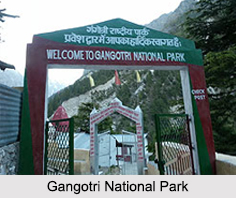 Gangotri National Park, situated in Uttarkashi district of Uttarakhand state, is a storehouse of wondrous coniferous forests and vibrant green meadows which shelter a vast repertoire of fauna. The area enclosed by the park also serves to connect Kedarnath Wildlife Sanctuary and Govind Pashu Vihar. The most captivating features of the park include narrow valleys, deep gorges, rocky craggy glaciers, high ridges and precipitous cliffs. The origin of Ganga River, known as Gaumukh, is located inside Gangotri National Park and it derives its name from a sacred Hindu shrine Gangotri.
Gangotri National Park, situated in Uttarkashi district of Uttarakhand state, is a storehouse of wondrous coniferous forests and vibrant green meadows which shelter a vast repertoire of fauna. The area enclosed by the park also serves to connect Kedarnath Wildlife Sanctuary and Govind Pashu Vihar. The most captivating features of the park include narrow valleys, deep gorges, rocky craggy glaciers, high ridges and precipitous cliffs. The origin of Ganga River, known as Gaumukh, is located inside Gangotri National Park and it derives its name from a sacred Hindu shrine Gangotri.
Location of Gangotri National Park
Gangotri National Park spans over an area of 1553 square kilometres and offers a majestic view of the glacial world. It spreads in the upper catchment area of Bhagirathi River with its north eastern boundary coinciding with the international boundary with China. The park includes a major stretch of snow capped mountains and glaciers. The elevation of the land in the park is highly varying ranging from 1,800 to 7,083 metres.
Flora of Gangotri National Park
Flora of Gangotri National Park mainly comprises western Himalayan alpine shrub and meadows at higher altitudes and western Himalayan sub-alpine conifer forests at lower altitudes. Prominent species of plants include rhododendron, oak, spruce, fir, deodar and chirpine. Patches of alpine scrub are dominant in both lower and higher altitudes, however in lower altitudes forest of kharsu oak and in higher altitude forests of betula are also found in abundance.
 Fauna of Gangotri National Park
Fauna of Gangotri National Park
The diverse flora of Gangotri National Park in turn shelters a vast array of fauna including 15 species of mammals and 150 varieties of birds. Several rare and unique species of fauna also grace the biodiversity of the park. Significant species found here include Himalayan Tahr, Blue Sheep or Bharal, Musk Deer, Brown Bear, Black Bear, Ibex and Snow Leopard. Exotic species of birds which inhabit the park are Bulbul, Parakeet, Pigeons, Doves, Partridges, Pheasants, Serow, Himalayan Snowcock, Koklass, Himalayan Monal and Himalayan Barbet.
Ecology of Gangotri National Park
Ecosystems of Gangotri National Park starkly resemble the high altitude ecosystems having greater impact of Trans Himalayan elements in its both biological and physical characteristics. Consequential landslides have prominently broken the steep mountain slides and have also resulted in irreversible isolation of forest patches in the park. These natural events greatly affect the biodiversity of both flora and fauna.
Visiting Information of Gangotri National Park
The period between April to October is considered as ideal for tourism in Gangotri National Park. Dehradun is the nearest railway station and airport to reach the park. Harsil is the nearest town of Gangotri National Park situated at a distance of 30 kilometres.











